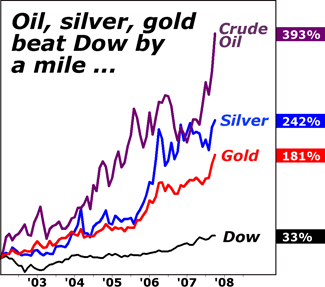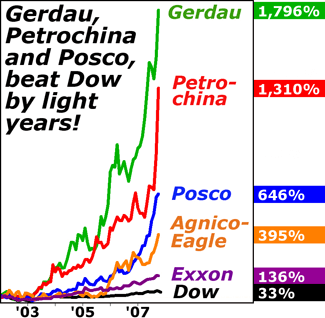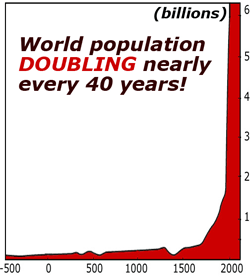Megaforces Shaping The Greatest Global Wealth Shift of All Time
Stock-Markets / Emerging Markets Nov 20, 2007 - 02:09 AM GMT Martin here with a Big-Picture reality check for all investors, For several years, observers called the U.S. a "Goldilocks" economy — blessed with low inflation, rising profits and no major disasters.
Martin here with a Big-Picture reality check for all investors, For several years, observers called the U.S. a "Goldilocks" economy — blessed with low inflation, rising profits and no major disasters.
And more recently, to help keep the party going, the Fed has pumped in hundreds of billions in fresh cash, slashed its discount rate three times and cut the Fed funds rate twice.
But despite all this ...
The U.S. stock market has consistently and persistently fallen woefully behind other key markets and commodities — month after month, year after year.
Let's say, for example, that on the first day of trading in January of 2005, you invested $10,000 in the average Dow stock. And let's stay you stuck with it through thick or thin. Right now, you'd be doing OK. But your total gain — even after nearly three years — would be only $3,300, or 33%.
If, on the other hand, you invested that same $10,000 in the exchange-traded fund representing Australia's bluechips (EWA), you'd have a gain of $10,600 — more than three times better than the gain in the Dow.
Or had you bought the equivalent ETF for South Korea (EWY), you'd now have a gain of $14,100 — over four times better than the Dow's.
And neither of these came even close to the performance of our two favorite county ETFs:
Brazil: The same $10,000 investment in the Brazil ETF has now generated a gain of $29,700 gain, or 297%. And meanwhile ...
China: $10,000 in one of our favorite China ETFs (FXI) has generated a gain of $30,300, or 303%.
With either of these, you'd now have over nine times more gains than investors in the Dow.

The Dow's mediocre performance is equally obvious when compared to key natural resources:
Between the first day of trading of 2002 and the close of business this past Friday ...
![]() Gold has risen 181%, or five and a half times more than the Dow ...
Gold has risen 181%, or five and a half times more than the Dow ...
![]() Silver is up 242%, or over seven times more than the Dow, and ...
Silver is up 242%, or over seven times more than the Dow, and ...
![]() Crude oil has surged 393%, 12 times more than the Dow in the same period.
Crude oil has surged 393%, 12 times more than the Dow in the same period.
Clearly, investors who put their money into foreign markets and natural resources have made out like bandits, while those in the Dow have been left behind in the dust.
But even the spectacular gains made in country ETFs and natural resources pale in comparison to the profits made by investors who bought shares in many of the companies that develop and produce those resources.

Case in point:
Instead of using the $10,000 to buy Dow stocks, if you had used it to scoop up a few shares in one of Larry Edelson's favorite energy companies, Petrochina, today you'd be looking at gains of $131,000 — more than 39 times the Dow gains made during the exact same exact period.
One of my personal favorites did even better: Gerdau, Brazil's premier steel producer, is up 1,796% since 2002. That's enough to generate $179,600 in pure profits on a single $10,000 investment (minus any broker commissions, of course).
Why This Huge Gap Between The Dow And Other Investments Must Not Be Ignored
IF the discrepancy between the Dow and these other investments could be measured in single digits, it would not carry such great significance.
Or ...
IF the gap had occurred during a short time period, you might be able to write it off as an "isolated event."
Or ...
IF the gap were appearing in just one select country ... one commodity ... or one country ... you could argue that it might be a fluke.
But that's certainly not the case here. Quite the contrary, just from the small sampling I've shown you this morning, it's obvious that we have the broadest, most persistent megatrend of our time.
We are witnessing the greatest wealth shift of all time — from industry to mining and agriculture ... from the traditional industrial power centers in the West to new power centers in the East and South ... from paper assets to hard assets.
This massive wealth shift is not just a flashback to the late 1970s. Nor is it just a forecast of some future, uncertain event. It's here. And it's now.
So unlike those who anticipated it prematurely in previous decades, investors don't have to sit around for years, waiting for it to begin. Even for latecomers, this megatrend can start creating new riches almost immediately.
And unlike previous cycles that came and went quickly, this one is driven by four megaforces that show no sign of ebbing. Instead, they show every sign of gaining momentum.
The first two megaforces are so fundamental and so long term, it could take decades to reverse them even in the best case scenario. The next two are more immediate and more fluid.
And right now, all four are converging to create an even greater gap between the U.S. stock market and other investments ...
Megaforce #1
The Global Population
Explosion Is Fueling
A Parallel Explosion in
the Demand for Resources
Consider the dramatic demographic change that has occurred in the span of just one lifetime:

In 1908, when my father was born, it had taken approximately 125 years for the population of the planet to double in size.
In 1996, when we gave our last seminar together, it had taken only 40 years for the world's population to double.
Or consider the massive transformation of the world's cities.
When I was born in 1946, the financial and industrial centers of the northern hemisphere — New York, London, Paris and Chicago — were among the largest cities in the world.
Since then, they have grown little or even shrunk in size. Meanwhile, southern hemisphere cities like Mumbai, Mexico City, São Paulo and Jakarta are now 7, 8, 10, even 12 times larger.
As long as emerging countries had weak currencies ... and as long as their exploding populations had little or no purchasing power ... they generated negligible demand for scarce resources and had little impact on world commodity prices.
But now, all that has changed virtually overnight: The currencies of emerging markets are among the strongest in the world. And the growth in their purchasing power is three, four, even five times faster than ours.
Just last week, we learned that China's industrial production surged 17.9% from last year — that's over nine times more quickly than ours, which was up just 1.9% in a similar period. And just last week, we also learned that their disposable income, retail sales, and auto sales are catapulting higher at rates that would make American economists green with envy.
All this generates huge — and rapidly growing — demand. So is it any wonder that the value of the world's natural resources is surging so many times faster than the Dow?
Megaforce #2
Global Warming Now Threatens to Destroy
A Larger Portion of the World's Crops
With Floods, Droughts and Other Disasters
Just hours ago, the UN's Intergovernmental Panel on Climate Change (IPCC) completed five years of work by more than 2,500 scientists, 1,250 authors and 130 countries — all with final approval from their heads of state, including President Bush.
Their conclusions are far more alarming than anything published to date:
- The world may have now surpassed the red-light warning zones described just four years ago as "the worst case scenario" for carbon emissions.
- The panel has estimated a very worrisome — but virtually unavoidable — increase in the globe's temperature of from one to four degrees by the end of the century.
- That estimate assumes governments will drastically change their current policies. If they don't change, the world's temperature could rise by six degrees and do so by 2030 .
- Just in the four years since the data for the IPCC study were first collected, the situation has gotten far worse, as new data confirms. But many of the IPCC's conclusions are based on the old, outdated information that was not nearly as bad as today's. In short, global warming has already gotten worse faster than the panel could write it up.
Megaforce #3
Housing Bust,
Mortgage Meltdown,
And Credit Crunch
Guarantee a U.S. Recession
While emerging markets and natural resources are being propelled forward by rapid growth, the U.S. economy is being held back — or even dragged down — by the housing bust, mortgage meltdown and credit crunch.
The crux of the problem: Most consumers and corporations in America are addicted to debt. And now, a larger and larger percentage is getting cut off, with serious withdrawal pains.
The best evidence: The Fed's just-released bank survey, which demonstrates just how severely lenders are now tightening their credit standards. The survey shows that ...
- A higher percentage of banks are tightening standards on commercial and industrial loans than at any time since the first quarter of 2003.
- Far more banks are charging wider spreads on their loans. In other words, they're increasing the amount of extra interest cushion they need above and beyond their cost of funds to make commercial loans.
- On non-traditional mortgages, a key measure of tightening standards has jumped by a whopping 50% just since last quarter.
- Banks are also clamping down on conventional mortgages; the percentage of banks reporting tighter standards in this sector has now jumped to the highest level since 1991.
- Even lending for commercial real estate is getting slammed, with more banks toughening their standards than at any time since 1990. (See Mike Larson's blog .)
This is serious. And in my view, it virtually guarantees a recession in the United States. But it also guarantees a continuation of ...
Megaforce #4
Massive Money-Pumping
By the U.S. Federal Reserve
In previous cycles, when the dollar plunged, the Federal Reserve would almost automatically intervene to help slow the trend.
Today, the Fed is doing precisely the opposite. It's running the money printing presses at full speed, flooding the economy with cold cash, and making it plainly clear that it virtually guarantees a growing economy.
But for an economy already slammed by the worst credit crunch in a generation, it's too little, too late. It's simply not enough to prevent a recession.
And for world commodities already surging in cost, it's too much, too soon — driving them even higher.
Bottom line: The massive wealth shift from traditional investments like Dow stocks to alternatives — such as emerging markets, commodities and commodity stocks — is just beginning.
Great news: So much is happening so fast — with so many new profit opportunities we want to alert you to — we've decided to expand Money and Markets from six to seven times per week.
Mike Larson will resume writing his regular update each Friday. Jack Crooks will bring you the latest on the dollar and foreign currencies every weekend. And the rest of our team will continue to deliver to you their current insights for the balance of the week.
Good luck and God bless!
Martin
This investment news is brought to you by Money and Markets . Money and Markets is a free daily investment newsletter from Martin D. Weiss and Weiss Research analysts offering the latest investing news and financial insights for the stock market, including tips and advice on investing in gold, energy and oil. Dr. Weiss is a leader in the fields of investing, interest rates, financial safety and economic forecasting. To view archives or subscribe, visit http://www.moneyandmarkets.com .
Money and Markets Archive |
© 2005-2022 http://www.MarketOracle.co.uk - The Market Oracle is a FREE Daily Financial Markets Analysis & Forecasting online publication.



